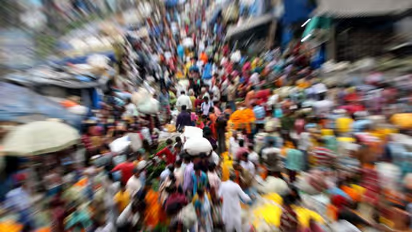India needs a new Census to silence Wang Wenbin

Synopsis
The new Census give us answers to Wang Wenbin’s challenge to the 'quality' of India’s population, says Girish Linganna
The UN population fund reported on April 19 that India's population would reach 1.4286 billion by mid-2023, compared to China's 1.4257 billion. On that day itself, China's foreign ministry spokesman Wang Wenbin was openly dismissive of fears about a demographic catastrophe in China as Guangdong, that country's largest export region, last year, had registered its first striking population decline in more than 40 years.
Wang claimed that China’s demographic dividend had not vanished and its workforce was more educated (than that of India’s). "I want to tell you that population dividend does not depend on quantity alone, but also on quality," Wang remarked obliquely. This would make one reflect: Can India say the same of its teeming multitude?
According to figures issued earlier this month by the Guangdong Provincial Bureau of Statistics, the southern province's resident population -- those who have lived in the region for more than six months -- declined by 272,000 from the previous year's 126.57 million. The population decline was the result of out-of-province migrants temporarily returning to their hometowns following the 2022 Covid outbreak, the bureau explained after the first decline was registered since data recording began in 1978.
Last year, China's overall population declined by 850,000 to 1.4118 billion, marking the first decline in six decades, as the national birth rate plummeted to a historic low of 6.77 births/1,000 people.
India's last Census in 2011
Demographers had initially predicted that India would overtake China in April. But the data was difficult to extrapolate because India had performed its most recent population Census in 2011, with the anticipated 2021 survey postponed owing to the pandemic.
The 2021 Census was also supposed to be the first step toward creating a National Register of Citizens -- a measure which, alongside changes to the citizenship law, caused huge nationwide protests to break out in 2019 because it was feared that a large section of Indian Muslims could be rendered stateless. But the plan seems to have gone on the backburner ever since.
Scenario over the next 20 years
By 2041, some government estimates have predicted that Bihar in India's north will have added 50 million people to the recorded figure of 104 million enumerated in the 2011 Census, while the population in the southern states is now growing below 1 per cent.
The total fertility rate (TFR) is, at present, below replacement-level fertility in 13 out of the 22 major states. In fact, such states as Tamil Nadu, Andhra Pradesh and Telangana have touched a low of 1.6-1.7 TFR.
Notably, the states that are set to have a reduced populace are ruled mostly by strong regional parties -- such as the Dravida Munnetra Kazhagam (DMK) in Tamil Nadu, Left Democratic Front (LDF) in Kerala, YSR Congress in Andhra Pradesh and Bharat Rashtra Samithi (BSR) in Telangana -- that do not speak a unified language as in the north, despite being much more prosperous.
New population numbers could mean that the share of seats in these states in India’s Parliament will shrink, leaving them little say in central government decisions. There is also the concern of unemployment. With little or no reliable data on the number of jobs being created for its teeming millions, a further population explosion may mean that many more hungry mouths to fill and that many dissatisfied, discontented and disgruntled souls seeking newer avenues of earning their daily bread, including through crime!
Bloomberg quoted a report of the first Periodic Labour Force Survey of the National Sample Survey Office released on May 31, 2019, saying the unemployment rate in India, across urban and rural areas, stood at 6.1% between July 2017 and June 2018. According to the annual report, the unemployment rate for females (rural and urban) stood at 5.7% and, for males (rural and urban) at 6.2%. This suggested a huge jump in unemployment in six years, as the all-India unemployment rate was 2.7% in the 2011-’12 period.
We did get more than a hint from the 2011 Census that 28% of households had at least one person 'seeking or available for work'. Also that there were 47 million unemployed people between the ages of 15 and 24 -- with a total youth unemployment rate of 20%. If that rate has, meanwhile, risen even further, it would not augur well for a government pitching the 4 'E's -- education, employment, entrepreneurship and excellence -- to its hordes of aspiring and ambitious youths.
The new census would also ascertain how many Indians have access to education and healthcare, and how much their earning potential is. It would also let us know if migration is still the major route to securing work. Would that not, in effect, give us answers to Wang Wenbin’s challenge to the 'quality' of India’s population?
India, by all estimates, is the world’s largest country by population and will remain so for the foreseeable future. But whether India will regain its lost pride of place in the Empire of Nations is still to be tested.
The author of this article is a Defence, Aerospace and Political Analyst
Stay updated with the Breaking News Today and Latest News from across India and around the world. Get real-time updates, in-depth analysis, and comprehensive coverage of India News, World News, Indian Defence News, Kerala News, and Karnataka News. From politics to current affairs, follow every major story as it unfolds. Get real-time updates from IMD on major cities weather forecasts, including Rain alerts, Cyclone warnings, and temperature trends. Download the Asianet News Official App from the Android Play Store and iPhone App Store for accurate and timely news updates anytime, anywhere.